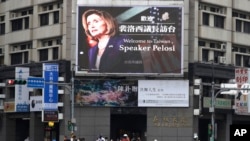Welcome back to the China In Eurasia briefing, an RFE/RL newsletter tracking China’s resurgent influence from Eastern Europe to Central Asia.
I’m RFE/RL correspondent Reid Standish and here’s what I’m following right now.
U.S. House Speaker Nancy Pelosi’s visit to Taiwan has already sparked a strong response from Beijing, with Chinese live-fire military exercises near the self-governing island under way, and a slew of sanctions targeting Taipei.
But the visit has also been a boon for Chinese propagandists, whose aggressive rhetoric accusing Pelosi of reckless behavior and warnings of a tough Chinese response are also being echoed by their Russian counterparts.
Finding Perspective: Even before Pelosi touched down in Taipei, an intensified Chinese campaign was under way -- the latest phase of a long-standing information war waged against Taiwan.
Rumors and false stories have spread quickly around Chinese language online spaces, with claims of Chinese fighter jets crossing into Taiwanese airspace (that were quickly dismissed by Taipei). Online attacks dominated Taiwanese websites, while Taipei’s government sites were hit by a series of cyberattacks.
While Chinese disinformation and propaganda campaigns are meant to target a domestic audience and Taiwan itself in hopes of paving the way for reunification between Beijing and Taipei, Russia has been targeting a different audience.
Perhaps unsurprisingly, the Kremlin -- which is engaged in a deepening partnership with Beijing and is increasingly reliant on it after its invasion of Ukraine -- has been outspoken against the visit, with Russian Foreign Ministry spokeswoman Maria Zakharova calling it a “provocation” aimed at pressuring Beijing and expressing full solidarity with China.
Russian media, meanwhile, have copied these Chinese narratives, with state TV’s Yevgeny Popov saying that Pelosi intended to use the visit to “turn the planet into dust.”
Why It Matters: While Ukraine war coverage is still the big-ticket item for Russian propaganda, the Taiwan visit highlights how state-run outlets in both countries are increasingly laundering each other’s talking points.
A new phase of this was observed in the early days of Russia’s invasion, when Chinese media echoed the Kremlin's justification for the war and often parroted false claims about events while ignoring commentary from Kyiv.
In the case of Pelosi's trip, the development is noteworthy due to the broad reach to other countries in the former Soviet Union where Russian is still widely spoken, but where Chinese state outlets have minimal reach.
Even despite concerns from local governments set off by the invasion of Ukraine, Russian propaganda outlets still have a broad following in many areas, with my colleagues from RFE/RL’s Central Asian services telling me that Russian state-run media have been eagerly spreading alarm about Pelosi in their broadcasts and amplifying Beijing’s narrative to regional audiences.
Read More
● Why did Pelosi decide to go to Taiwan? As Politico’s Andrew Desiderio writes in this profile, it’s the latest move in the speaker’s long career of challenging Beijing.
● As Beijing reacts loudly to Pelosi’s visit, Bonny Lin and Jude Blanchette argue in Foreign Affairs that Chinese foreign policy in the coming years “will increasingly be defined by a more bellicose assertion of its interests and the exploration of new pathways to global power that circumvent chokepoints controlled by the West.”
● For more on Taipei’s precarious place in the world, read my interview with Taiwanese Foreign Minister Joseph Wu from October where we discussed the island’s outreach to Europe and rising pressure against it from Beijing.
Expert Corner: Theorizing On BRI 2.0
Here are excerpts from a conversation I had with Bradley Parks, executive director of the AidData Lab at the College of William and Mary in Virginia, which has extensively researched China’s lending practices abroad, about what’s next for the Belt and Road Initiative (BRI) and how Beijing could look to streamline it in the future.
“As originally conceived, BRI cannot sustain itself according to its original vision, but we shouldn’t underestimate the Chinese. They are quite strong at learning and adapting to their past mistakes and we’ve heard from our contacts in Beijing that they have used the COVID lockdown period as an opportunity to do some introspection about what BRI 2.0 is going to look like.
“They currently face a big problem in their risk profile. They don’t have strong safeguards for dealing with debt, governance, and environmental concerns, so one of the ideas is to start co-financing with multilateral institutions and outsource some of the due diligence to those that can better follow best practices and international standards.
“The next [idea] is Public-Private Partnerships (PPP). The era of BRI projects via sovereign debt is very quickly coming to an end. Governments can only take on so much debt before it becomes unsustainable. So one thing that is being considered is what if instead of lending to the sovereign [government], they set up project companies and then lend to those Special Purpose Vehicles and use them to repay the loans.… There are certainly questions about whether this all could work and nothing appears to be decided yet, but these are some of the discussions happening.”
Do you have a question about China’s growing footprint in Eurasia? Send it to me at StandishR@rferl.org or reply directly to this e-mail and I’ll get it answered by leading experts and policymakers.
Three More Stories From Eurasia
1. Welcome To The New BRI
China is currently navigating the country’s first overseas debt crisis sparked by a mountain of nonperforming loans handed out over the last 10 years that risks sparking a series of defaults that could test the future of Beijing’s signature foreign policy project, I reported here.
What It Means: Launched in 2013, the BRI paved the way for China to become the world’s largest source of development credit and saw a rapid expansion of loans issued from Chinese institutions for large-scale infrastructure projects.
Now, the BRI faces new headwinds. According to data collected by Rhodium Group, a New York-based research consultancy, the total value of loans from Chinese institutions that required renegotiation in 2020 and 2021 surged to $52 billion -- a threefold increase from the previous two years.
The debt crisis continues to spread, with the World Bank warning it could trigger a series of defaults not seen since the 1980s. Currently along the BRI, 60 percent of Chinese loans are to countries that are now in financial distress, compared to only 5 percent of Chinese lending back in 2010.
The current debt pressure is accelerating a rethink in Beijing that was already under way about how China should lend in the future and avoid similar blowback.
A new report from the Green Finance and Development Center at Fudan University in Shanghai found that China is increasingly investing in oil and gas, making up about 80 percent of Chinese overseas energy investments for the first half of 2022 and 66 percent of Chinese construction contracts.
Christoph Nedopil Wang, the center’s director, told me that this is because energy investments are far less risky than other big infrastructure projects that have tended to make up the majority of BRI spending.
“There is a more straightforward way for you to get your money back, which is not the case with other big infrastructure projects that have much longer payback periods with much higher uncertainty,” he said.
2. What's On Georgia's Mind
Georgian Prime Minister Irakli Garibashvili met with President Qasym-Zhomart Toqaev in Kazakhstan where the two discussed boosting trade and how to expand the “Middle Corridor” of the BRI that bypasses Russia as it moves goods between Europe and China, RFE/RL’s Kazakh Service reported.
What You Need To Know: Georgia, along with other countries, is looking to capitalize on the fallout from Moscow’s invasion of Ukraine that has seen freight traffic dwindle through Russia, which was previously the main route bringing goods by rail between China and Europe.
The rising alternative has been the roughly 6,500-kilometer network of roads, railroads, and ports stretching across Kazakhstan, the Caspian Sea, Azerbaijan, Georgia, Turkey, and into Europe known as the Trans-Caspian International Transport Route or Middle Corridor.
The trade route is expected to see a sixfold increase in traffic in 2022 due to freight diversions from the war. Governments along the path, with Georgia leading the charge, are searching for new opportunities to attract investments as global transport companies turn away from Russia.
3. How Hungary Sees China
A July poll shows that support for China in Hungary is growing, with a majority of voters saying they approve of rising Chinese influence in the country, RFE/RL’s Hungarian Service’s Balint Szalai and I reported.
The Details: The survey by the Budapest-based Central and Eastern European Center for Asian Studies (CEECAS) found that China generally has a positive image among the Hungarian public and that most voters in the country share views on important political issues that are “favorable to Chinese standpoints.”
Among some notable findings, 51 percent of Hungarian voters said they felt optimistic about China’s expanding footprint in the country and a majority of respondents said they saw Beijing as having a high degree of influence in the country.
The favorable views of China skewed further toward voters of Prime Minister Viktor Orban’s Fidesz party in Hungary’s polarized political system, but interestingly, when it came to views of Beijing and Moscow’s deepening partnership, 48 percent of voters had an unfavorable view of it.
According to the survey, “This was the only question in which a majority did not [hold] a positive perception [toward] China’s role.”
Across The Supercontinent
Regional Tour: Chinese Foreign Minister Wang Yi recently wrapped up a regional tour of Central Asia where he reaffirmed Chinese support amid economic and political problems, RFE/RL’s Kazakh Service reports.
Bishkek To Beijing: In interesting comments that point to how the region is viewing China these days, Kyrgyz President Sadyr Japarov said he sees Beijing as his country's main economic partner in the world, not Moscow, Kyrgyzstan’s traditional patron.
A Kyrgyz Wish List: Despite the warm words, Bishkek had a growing wish list of issues that it wants to resolve with Beijing and were discussed during Wang’s visit. Chief among them, as Yrysbek Ulukbek from RFE/RL’s Kyrgyz Service reported, was trying to revive cross-border trade to pre-pandemic levels.
Russian Rail Looks East: Getting the China-Kyrgyzstan-Uzbekistan railway fully off the ground is another wish list item, a project that the Russian-led Eurasion Union recently endorsed.
Having Moscow’s blessing gives the Chinese-backed project more momentum and also lines up with Russian Ministry of Transportation plans to potentially invest $30 billion in rail construction across Central Asia and Mongolia between now and 2030.
One Thing To Watch
Pakistan is facing an economic default and could be the next Sri Lanka as the world faces a wave of debt crises, but Islamabad says that it sees a solution.
Pakistani Finance Minister Miftah Ismail told Bloomberg recently that progress had been made on a stalled International Monetary Fund (IMF) loan to Islamabad, which could stave off a worst-case scenario.
Pakistan’s economic problems have worsened in recent months, and a consortium of Chinese state banks lent $2.3 billion to Pakistan to help the country stave off a foreign payments crisis in late June. But while China gave the loan, its chief concern was to avoid a Pakistani bankruptcy, and Beijing has urged Islamabad to repair ties with the IMF and revive a $6 billion loan program.
How this gets solved will have implications for other struggling economies with large debts to China and will also impact Beijing and Islamabad’s close but increasingly frayed relationship.
That’s all from me for now. Don’t forget to send me any questions, comments, or tips that you might have.
Until next time,
Reid Standish
If you enjoyed this briefing and don't want to miss the next edition, subscribe here. It will be sent to your in-box on the first and third Wednesdays of each month.







